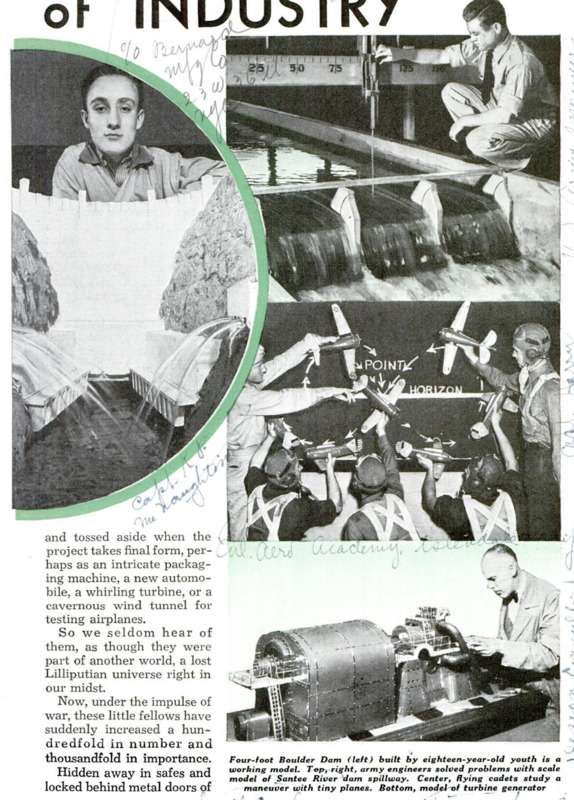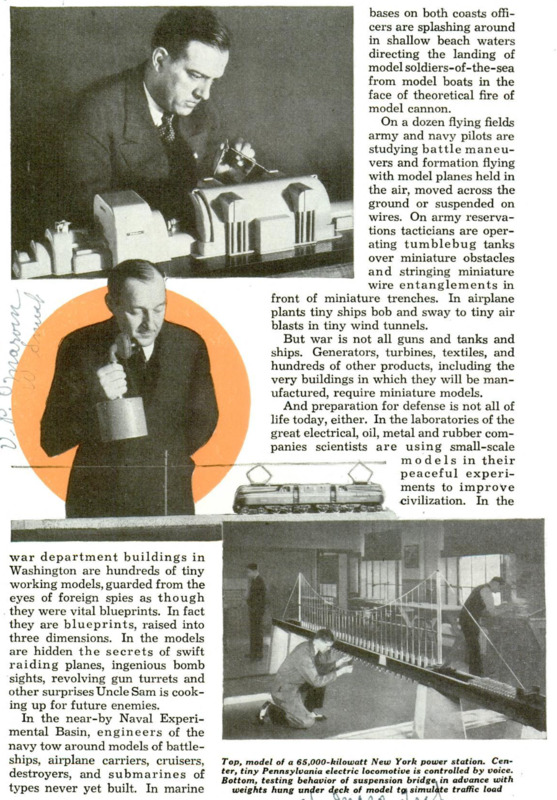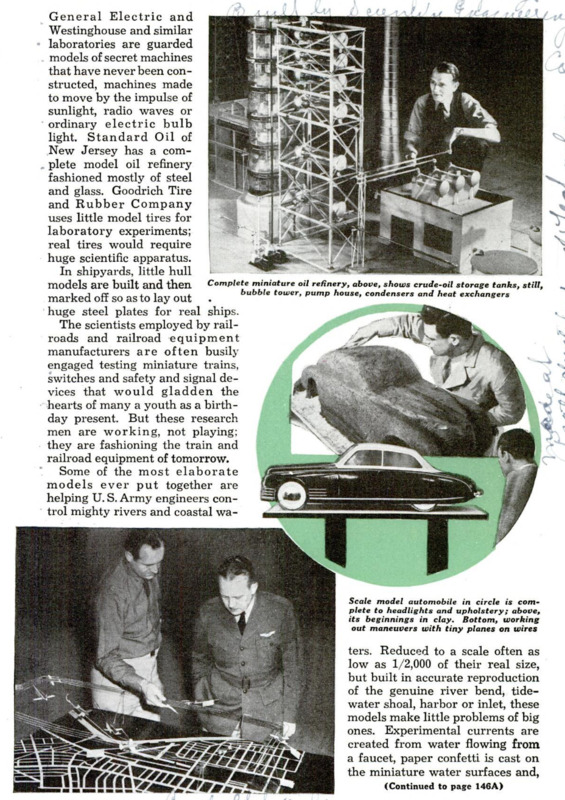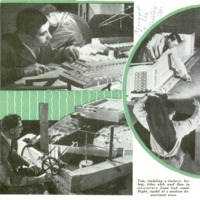IF YOU were to select the most remarkable characteristic of modern industry, probably the first thing that would come to your mind is size - huge buildings, gigantic machines, massive ships, great airplanes, bulky trucks, mammoth dams, tall derricks, towering excavators, long trains. Man himself seems puny and weak beside his creations. The second characteristic you might note would be the complexity of the ingenious devices, which often taxes the average human capacity for understanding. Indeed, achievements of recent years have pretty nearly shown that whatever man can imagine he can build. And they have brought a new problem, the difficulty of visualizing and pretesting these entirely novel and untried scientific and mechanical wonders. A roll of blueprints is a poor aid to the imagination. And, since the best test of a theory is to prove that it can be made to work, modern industry has turned more and more to the use of miniature models, precise in form, scale and operation. These little giants of industry have been throwing a tremendous weight behind the forward-moving wheels of progress. Vitally necessary during the early stages of thousands of projects, they are forgotten, and tossed aside when the project takes final form, perhaps as an intricate packaging machine, a new automobile, a whirling turbine, or a cavernous wind tunnel for testing airplanes. So we seldom hear of them, as though they were part of another world, a lost Lilliputian universe right in our midst. Now, under the impulse of war, these little fellows have suddenly increased a hundredfold in number and thousandfold in importance. Hidden away in safes and locked behind metal doors of war department buildings in Washington are hundreds of tiny working models, guarded from the eyes of foreign spies as though they were vital blueprints. In fact they are blueprints, raised into three dimensions. In the models are hidden the secrets of swift raiding planes, ingenious bomb sights, revolving gun turrets and other surprises Uncle Sam is cooking up for future enemies. In the near-by Naval Experimental Basin, engineers of the navy tow around models of battleships, airplane carriers, cruisers, destroyers, and submarines of types never yet built. In marine bases on both coasts officers are splashing around in shallow beach waters directing the landing of model soldiers-of-the-sea from model boats in the face of theoretical fire of model cannon. On a dozen flying fields army and navy pilots are studying battle maneuvers and formation flying with model planes held in the air, moved across the ground or suspended on wires. On army reservations tacticians are operating tumblebug tanks over miniature obstacles and stringing miniature wire entanglements in front of miniature trenches. In airplane plants tiny ships bob and sway to tiny air blasts in tiny wind tunnels. But war is not all guns and tanks and ships. Generators, turbines, textiles, and hundreds of other products, including the very buildings in which they will be manufactured, require miniature models. And preparation for defense is not all of life today, either. In the laboratories of the great electrical, oil, metal and rubber companies scientists are using small-scale models in their peaceful experiments to improve civilization. In the General Electric and Westinghouse and similar laboratories are guarded models of secret machines that have never been constructed, machines made to move by the impulse of sunlight, radio waves or ordinary electric bulb light. Standard Oil of New Jersey has a complete model oil refinery fashioned mostly of steel and glass. Goodrich Tire and Rubber Company uses little model tires for laboratory experiments; real tires would require huge scientific apparatus. In shipyards, little hull models are built and then marked off so as to lay out huge steel plates for real ships. The scientists employed by railroads and railroad equipment manufacturers are often busily engaged testing miniature trains, Switches and safety and signal devices that would gladden the hearts of many a youth as a birth- day present. But these research men are working, not playing: they are fashioning the train and railroad equipment of tomorrow. Some of the most elaborate models ever put together are helping U.S. Army engineers control mighty rivers and coastal waters. Reduced to a scale often as low as 1/2,000 of their real size, but built in accurate reproduction of the genuine river bend, tide-water shoal, harbor or inlet, these models make little problems of big ones. Experimental currents are created from water flowing from a faucet, paper confetti is cast on the miniature water surfaces and, by repeatedly photographing the movement of the paper particles, the engineers are often able to predict what tides and currents are actually doing in the bodies of water represented by the models. Similarly, river, canal and ocean experiments are conducted with models in other branches of government service and in such educational research organizations as that of Massachusetts Institute of Technology. In fact, the universities and technological institutions are among the most prolific producers of miniature models, used for instruction or to solve practical problems posed by an industry or a governmental agency. One important application of miniature models is their use to forecast the appearance of an office, skyscraper, hotel, apartment or industrial plant. In times gone by when a manufacturer ordered a factory built, he had a pretty good idea of what it would look like - a rectangular box with rectangular windows, so many to a floor. Lately, however, modern scientific discoveries have changed the construction industry. Air conditioning has eliminated the necessity for windows. Improved lighting and heating methods have changed ceiling heights. Smoke-control devices have often ruled out the need for towering chimneys, long the familiar landmark of the factories. Private airports have nudged factory buildings over to one side and baseball diamonds and recreation fields have squeezed in on the other. Garages and parking spaces are fitted in. Buildings are functional, laid out to follow the efficient lines of mass production, to take advantage of the force of gravity and to fit the machinery they house. Things have come to a pass where the industrialist is asked to invest a million or two in a building which he cannot visualize even with the help of blueprints and sketches. As a result, the construction of remarkably accurate structural miniature models has grown into a new art and science until it is becoming difficult to distinguish a two-foot model from a five-story factory building by comparing the photographs of both. Nowhere is the use of models so important as the automobile industry, where ex-ecutives operate on the thumb-rule theory that, no matter how clever and efficient the design of next year’s automobile may be, it simply won't sell unless it “looks right.” These men know that if a proposed automobile does not “look right” it will not be accepted by the average purchaser. Therefore during the period when the designing rooms of the automobile corporations are functioning at top speed there comes a time when the model is master of the gigantic industry. Thousands of sketches have been discarded, the best have been selected and then the model-makers get in their work. They spend days and weeks molding next year’s cars in quarter-size clay models, adding to a contour here or flattening a bulge there, working constantly and nimbly, using clay kept at exact temperatures in special electric ovens. When completed the models are given the eye test to see whether they will “look right” from all angles. Those models which pass this visual examination are then placed in wind tunnels where they are struck by a 100-mile-an-hour blast created by airplane propellers. If the model sways unduly under the force of the wind, the finished car will do the same. So a change is made in its form. If a fender or bumper sets up a hum, this hum would be a shrill scream in the full-sized automobile at high speed. Another change is necessary. The model finally accepted is so much like the car to be constructed that a clever photographer would make it hard to distinguish between them in a picture. So, in recent years the modelmaker has become an artist in his own right and the expert at his craft seldom finds it necessary to seek a job. History records that nearly fifty thousand years ago the cave man first began to perceive that if the tiny head of a cow was painted on a rounded bulge in the cave wall, it looked more natural than if daubed on a flat surface. He was the first model-maker and the bovine head was the first attempt at a model. Since then, model-makers and miniature models have had a long road to travel, but they seem to have arrived at their goal of perfection and their position of importance at last.
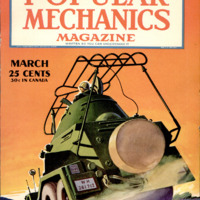 Popular Mechanics, v. 75, n. 3, 1941
Popular Mechanics, v. 75, n. 3, 1941


